Many teachers love to use icebreakers on the first day of school. But finding icebreakers for high school students can be a real challenge. Older kids can see the usual “getting to know you” activities coming from a mile away—and they don’t want to risk looking silly or awkward in front of their peers. The key is to make them forget themselves temporarily because they’re so wrapped up in the game. That’s where this list of activities comes in. (Tip: Most of them make terrific icebreakers for middle schoolers too!)
Jump to:
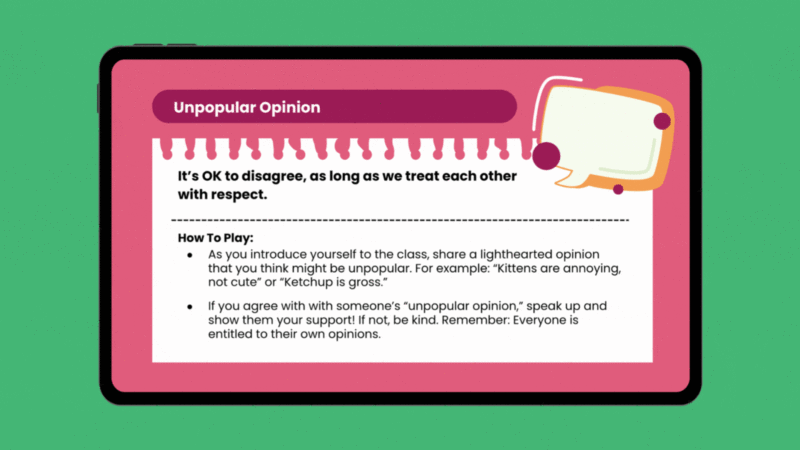
FREE GOOGLE SLIDES
Middle and High School Icebreakers
Grab our free Google Slides with all of the icebreakers below to share with your class!
What are the benefits of using icebreakers with high school students?
By high school, many of your students have probably known each other for years. But as a teacher, this may well be your first time meeting them. Spending some time getting to know them on a more personal level can help you forge valuable connections right from the start.
Icebreakers can also help set the tone for your class and teaching style. If you want kids to relax in your classroom and feel comfortable participating, the right icebreaker can set the stage for those expectations. When you’re interested in building a strong sense of classroom community, a first-day team-building activity sets things off on the right foot.
You can even use icebreakers to create or reinforce classroom rules and expectations, or introduce your curriculum for the year. They’re a lot more fun than simply reading the rules or reviewing a syllabus handout, and they encourage a positive classroom culture.
No matter why you’re using icebreakers with your class, you’re sure to find some interesting new activities on our list!
Getting To Know You Icebreakers for Middle and High School Students
Here’s a tip: Before you ask kids to tell you about themselves, be sure to introduce yourself first! We’ve got a great list of ways to introduce yourself to students here, and a lot of these can be flipped for your students to use too.
Now you’re ready to ask kids to reveal a bit about themselves. This is an opportunity to find ways to connect with them in the months ahead and for them to find new friends too. Here are some middle and high school icebreakers that really do help teachers and students get to know one another.
1. Unpopular Opinion
- Time: 15 to 20 minutes
- Materials: None
- Prep: None
How To Play:
- Show students one of the viral “unpopular opinion” videos, where someone defends a point of view like, “Kittens and puppies are annoying, not cute” or “Ketchup is gross.” (Be sure to watch the video first to ensure it’s appropriate for your audience.)
- As students introduce themselves, ask them to share one of their own unpopular opinions. They might be surprised to discover that some of their classmates agree!
2. Would You Rather … ?

- Time: 20+ minutes depending on the number of scenarios
- Materials: Would You Rather questions
- Prep: Choose questions and divide the room into two sections.
How To Play:
- Select questions that are a mix of funny and getting-to-know you types, such as: Would you rather do math homework or go for a 2-mile run? Read a book or watch a movie? Wrestle a gorilla or swim with alligators?
- Ask the first question, and assign one side of the room to each option. Ask students to move to the side that represents their choice, then let them chat amongst themselves for a minute or so.
- Repeat as many times as you like, giving students a chance to mix and mingle.
3. Classmate Bingo
- Time: 15 to 20 minutes
- Materials: Icebreaker Bingo Cards
- Prep: Copy bingo cards (one per student) and ensure each student has a pen or pencil.
How To Play:
- Use this free bingo card generator to create your own Classmate Bingo cards.
- Give one to each student, then ask them to move around the room, chatting to find other students who can initial each space. If you have enough students, make a rule that each student can only initial one space on any card.
- Offer small prizes to the first student to fill in a row or the first to fill their whole card.
4. Blobs and Lines
- Time: 15 to 20 minutes
- Materials: List of prompts for the “blobs” and “lines”
- Prep: None
How To Play:
- Make a list of ways for students to organize themselves in lines or blobs.
- Lines: In order by height, birthday, alphabetical by middle names, etc.
- Blobs: Grouped by type of shoes, hair color, favorite ice cream flavor, etc.
- Read out the first prompt, then step back and let students line themselves up or group themselves together without help or interference. Allow them a minute or two to chat in each arrangement.
- Continue with more prompts for as long as you like.
5. Speed Meetings
- Time: 15 to 20 minutes
- Materials: Icebreaker questions
- Prep: Arrange chairs or desks into two concentric circles so that participants will face each other in pairs.
How To Play:
- Divide the class in half, and have them sit in two concentric circles facing each other in pairs.
- Ask an icebreaker question, set a timer for 60 seconds, and let each pair discuss.
- When the timer dings, the outside ring moves one seat to the left. Give the new pairs a new question, and set the timer again.
- Continue until everyone has had a chance to chat with everyone else, or as long as time allows.
6. What Do You Meme?
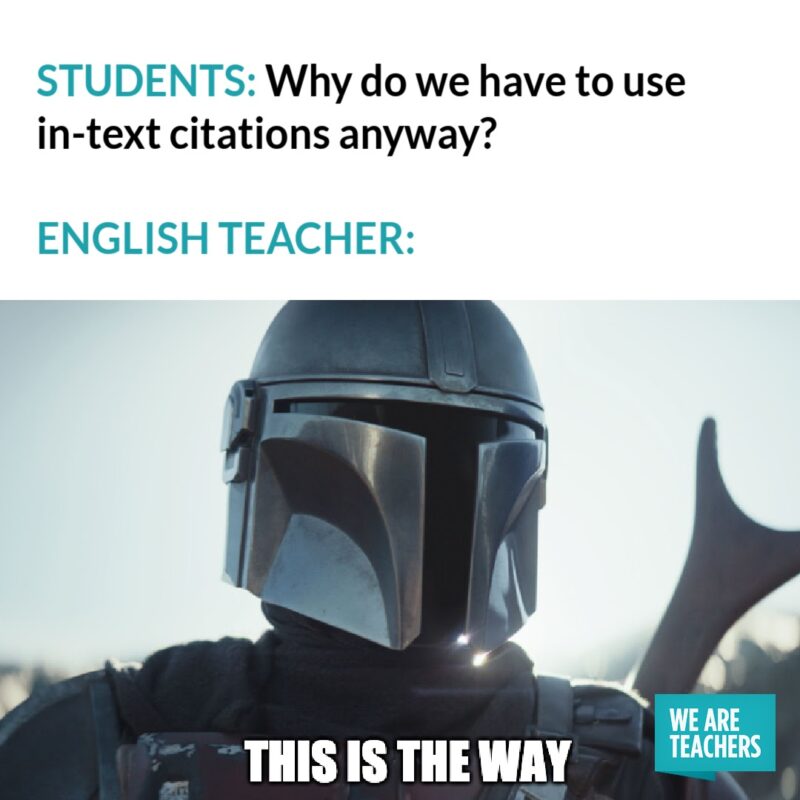
- Time: 5 to 10 minutes
- Materials: 5 or 6 meme printouts
- Prep: Post meme printouts in various places around the classroom, with space to gather around each.
How To Play:
- Find some popular meme images on the web, print them out, and post them in various places around your classroom.
- Ask students to find and stand by the meme that best represents how they feel about the subject you teach.
- Let them chat in these groups for a minute or two, then pose a few more icebreaker questions for them to group together and discuss.
7. Collaborative Playlist
- Time: 20 to 30 minutes
- Materials: A way to play some of the songs chosen for the playlist (optional)
- Prep: None
How To Play:
- Ask each student to contribute one song choice to a class playlist, along with an explanation of why they love that song. (Depending on students’ ages, you can decide on parameters for lyrics and language.)
- Create the list on Spotify so all students can listen to one another’s songs.
- If you allow music in your classroom, add this playlist to your collection.
8. Candy Share
- Time: 15 to 20 minutes
- Materials: Individually wrapped small candies, like Hershey’s Kisses
- Prep: None
How To Play:
- Pass around a bowl of small candy like Hershey’s Kisses, and invite each student to take as many as they like (ensure each student takes at least one), but don’t eat them yet.
- Once everyone has a handful of candy, explain that for each piece they took, they must share an interesting fact about themselves. (Then they can eat the treats!)
9. Two Truths and a Lie
- Time: 15 to 20 minutes
- Materials: None
- Prep: None
How To Play:
- Ask each student to share two facts about themselves and one lie, without identifying which one is untrue.
- Other students try to guess which one is the lie. Kids always have fun coming up with stuff to fool each other!
10. Funny Debate
- Time: 15 to 20 minutes
- Materials: None
- Prep: Choose a funny debate topic for the icebreaker.
How To Play:
- Pick a not-so-serious subject for debate, like what is the best pizza topping or whether or not clowns are scary.
- Ask students to gather in groups with others who share their opinion, and give them a minute or two to chat.
- Let the debate begin! Students take turns defending their points of view.
11. Word Clouds

- Time: 30 to 40 minutes
- Materials: Paper and pencils, or a computer with web access for each student
- Prep: Create a word cloud of your own to share with students.
How To Play:
- Explain to students that the words we choose to define ourselves can be really telling. Show them some word clouds and explain their purpose and design.
- Ask students to make a list of words that describe themselves. Circle or highlight words that feel the most important.
- Now, have students create word clouds! They can draw them by hand on paper, or try one of these free online word cloud generators instead. Remind them to make the words they chose as most important bigger, and encourage them to use a shape that represents themselves too.
12. Stand Up, Sit Down
- Time: 15 to 20 minutes
- Materials: Icebreaker questions
- Prep: Choose a series of icebreaker questions to use with your class.
How To Play:
- Ask an icebreaker question. If students answer yes, they stand up. If no, they sit down (or stay seated).
- Let kids look around to see how others have answered, then move on to the next question.
13. Paper Planes
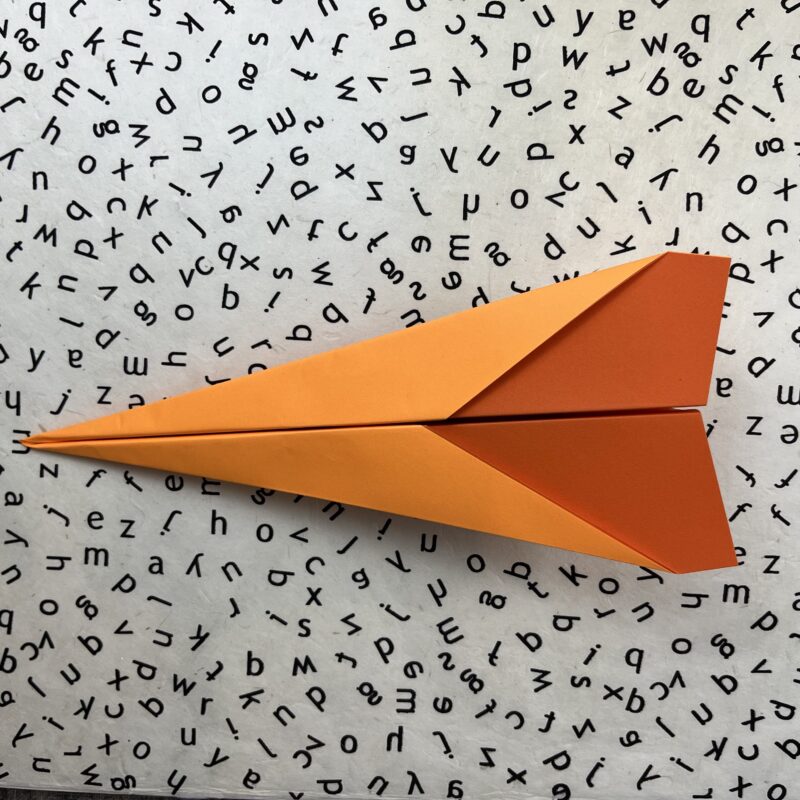
- Time: 30 to 40 minutes
- Materials: Pencils and paper, one piece for each student
- Prep: None
How To Play:
- Ask each student to write a get-to-know-you question on a piece of paper. (Encourage them to think creatively so you don’t wind up with the same question over and over again.)
- Then, have them fold the papers into planes and spend a minute throwing them across the room. (Here are some free printable paper airplane–folding directions.)
- Everyone picks up a plane, then takes turns answering the questions they’ve picked up.
14. Common Thread
- Time: 20 to 30 minutes
- Materials: None
- Prep: None
How To Play:
- Divide students into groups of four and have them sit together in these small groups.
- Give each group five minutes to chat amongst themselves and find something they all have in common. It could be that they all play soccer, or pizza is their favorite dinner, or they each have a cat. Whatever the common thread, the conversation will help them get to know one another better.
- Repeat this activity in new groups as many times as you like.
15. Show-and-Tell
- Time: 30 to 40 minutes
- Materials: None
- Prep: Contact students and ask them to bring an item for Show-and-Tell on the first day of class. Choose an item of your own to share too.
How To Play:
- Ask students to bring something for Show-and-Tell on the first day of class to help their classmates get to know them a little better.
- If students are unable to bring the actual item, they can share pictures instead. Consider posting the pictures on a bulletin board with a written explanation from each student so others can take a look when they have time.
16. Beach Ball Toss
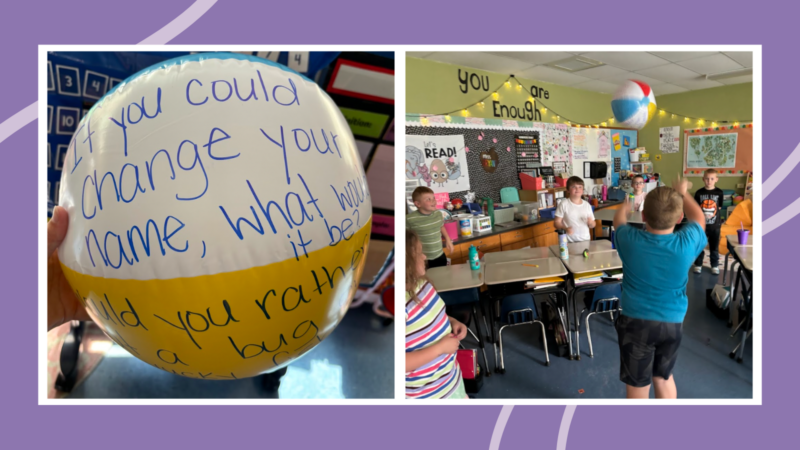
- Time: 15 to 20 minutes
- Materials: Beach ball, permanent marker
- Prep: Choose and write icebreaker questions on the beach ball.
How To Play:
- Start the game by tossing the ball to a student at random.
- Ask the student to look at the question their right thumb landed on, then share their answer with everyone.
- Then, have them toss the ball on to someone else. Continue until everyone has had a turn.
17. Say Hello!
- Time: 5 to 10 minutes
- Materials: None
- Prep: None
How To Play:
- Sit in a circle (or in a way that makes it easy for everyone to see each other).
- Ask one student to stand up and say, “Hi, my name is [name].”
- The whole class responds, “Hello, [name]!”
- They sit down, and the next person does the same. This is a terrific way to learn names, and it gives kids a chance to help others learn to pronounce theirs if it’s a little tricky.
18. Favorite Quote

- Time: 30 to 40 minutes
- Materials: Paper and markers; lists of quotations or a computer with web access for each student
- Prep: Choose a quotation of your own to share with the class.
How To Play:
- Ask students to choose their favorite inspirational quote. Give them a little time to do some web research or use our enormous collection of quotes to get started.
- Then, have them write their chosen quote on a piece of paper with colorful markers, decorating it however they like.
- Let each student share their quote and explain why they like it.
- Use the quotes to decorate your classroom walls or school hallways.
19. Candy Colors
- Time: 15 to 20 minutes
- Materials: Wrapped candies in different colors (we like Starburst or Life Savers)
- Prep: Choose one icebreaker question for each color. (For instance: Red—share the best meal you’ve ever eaten; green—tell us your favorite joke.)
How To Play:
- Pass around a bowl of wrapped candy that comes in different colors, and ask every student to choose just one but not eat it yet.
- After everyone has theirs, tell them they each must answer an icebreaker question based on the color they picked. Be sure to hide the questions until everyone has their candy in hand!
20. Find Me
- Time: 20 to 30 minutes
- Materials: Note cards and pencils (one per student)
- Prep: None
How To Play:
- Ask each student to write a unique fact about themselves on a note card.
- Gather and mix up the cards, then pass them back out randomly.
- Have students mingle and chat, trying to find the person who matches the card they’re holding.
- Repeat this over and over again so everyone has a chance to meet up and chat.
21. Fakebook Page
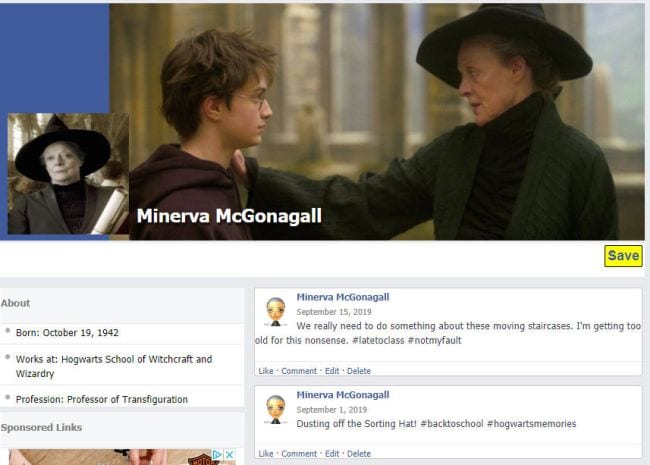
- Time: 30 to 40 minutes
- Materials: Computer with web access for each student
- Prep: Create your own Fakebook page.
How To Play:
- Give students the link to this classroom-safe free online Fakebook generator,
- Ask them to personalize their own page however they like, then take turns sharing the result with the class. (This also gives you a good opportunity for a lesson on responsible digital citizenship.)
Setting Classroom Expectations Icebreakers for Middle and High School Students
Many teachers start the first day of school by sharing their classroom rules, assigning seats, and introducing the year’s agenda. Now, let’s be honest: Most kids tune out when you start sharing your rules. They’ve heard them all before, right? So, try giving your students some ownership over the expectations in your classroom. You’ll be surprised at how this can be a real game-changer.
22. Seating Plan Spin
- Time: 20 to 30 minutes
- Materials: None
- Prep: Set up desks in the seating arrangement of your choice.
How To Play:
- Tell students that they’ll be creating the initial seating chart for your class. The only rule? They can’t pick “sit wherever we want.”
- Let them brainstorm ideas in small groups, then list all their ideas on the board for the whole class to see. (They might suggest options like “alphabetical by middle names,” “grouped by birthday month,” and so on.)
- Hold a vote to choose the winner. (You can veto any suggestions you dislike first.)
- Finally, let students figure out how to get themselves into the right seats using the rules they chose, and create your seating chart.
23. Right or Wrong Skits
- Time: 45+ minutes
- Materials: Paper and pencils (optional)
- Prep: Create your classroom rules and expectations.
How To Play:
- First, share your classroom rules and expectations.
- Divide kids into small groups, one for each rule. The group has 10 minutes to prepare short skits showing the right way to follow the rule and the wrong kind of behavior.
- Perform the skits for the class, group by group. Kids really have fun hamming up the wrong behaviors, and they’re all much more likely to remember your rules.
24. Classroom Constitution
- Time: 1 to 2 hours
- Materials: Paper and pencils
- Prep: None
How To Play:
- Tell your students that by middle school and high school, you know they generally understand the rules they need to follow. So, they’re going to work together to draw up a Classroom Constitution you can all agree on.
- Brainstorm expectations for a good classroom, then create the guidelines they’ll need to follow to make that happen.
- Craft the language and have everyone sign.
Note: This is a project that can take more than one day, but it’s especially fun in social studies, history, and government classes. Get a free online lesson to walk you through the process here.
25. Shared Goals
- Time: 30 to 45 minutes
- Materials: Chart paper and pencils or markers
- Prep: Select your questions, then write one on each piece of chart paper. Post the chart papers in various spaces around the room.
How To Play:
- Tell students that you want to find out what they really want to know and learn about in your class this year.
- Post a few anchor charts around the room with one question on each, like these:
- What do you think you’ll learn in this class this year?
- What do you really want to learn in this class this year?
- How can your teacher help you learn and succeed?
- What are you most looking forward to in this class?
- What do you dread most about this class?
- Have kids circulate and write their answers on the charts.
- Look each one over as a class and talk about the responses. Explain whether this class will meet their expectations, and if not, why not.
26. Blind Kahoot
- Time: 15 to 20 minutes
- Materials: Devices for students to respond to Kahoot questions
- Prep: Create a Kahoot quiz with questions that students will be able to answer by the end of the year but are unlikely to know now. The questions should cover the highlights of your course. Watch the video above for more information.
How To Play:
- Create (or find) a Kahoot that covers the basic fundamentals of your syllabus.
- Start with this quiz on the first day, explaining that you don’t expect them to know the answers yet. (Kids will likely moan and groan over each question, but it will give you a chance to learn what they already know, and help them discover what’s coming in the semesters ahead.)
27. Student Expectations
- Time: 15 to 20 minutes
- Materials: None
- Prep: None
How To Play:
- Tell students you’ll be asking them to share:
- Their name
- Their expectations of the class
- Their idea about the best possible outcome if their expectations are met
- Give them a couple of minutes to think about and jot down their answers.
- Ask each student to share. (An example might be “Hi, my name is Harper. I’m expecting to learn about the history of our country. My wildest expectation is that if I learn enough, I’ll be able to understand more about why we have such trouble agreeing politically.”)
28. Rules Snowball Fight
- Time: 15 to 20 minutes
- Materials: Paper and pencils
- Prep: Prepare your classroom rules and expectations.
How To Play:
- Introduce your classroom rules and expectations.
- Hand out blank pieces of paper to your students. Ask them to write down the rule they think is the most important.
- Now for the fun part: Have them crumple up the papers and throw them around the room (gently!) for 1 to 2 minutes.
- Have each student grab the paper nearest them. Read the rule aloud and keep track of how many times each one was chosen as most important.
- Afterwards, review the results and have a class conversation about what these results say about their own values and expectations.
Team-Building Icebreakers for Middle and High School Students
Team-building activities can be a lot of fun, though you’ve got to pick them carefully, especially with this age group. Be sure to debrief when you’re done—ask students to think about why you had them do this activity and what they learned from it. And if you’re choosing something physical, remember that not everyone in the class may be able (or willing) to participate, so think about how you’ll handle that in advance. Find a list of our favorite team-building games and activities here, which are great to use for high school and middle school icebreakers, or try some of the following ideas.
29. Tarp Flip Challenge
- Time: 15 to 20 minutes
- Materials: Large tarps
- Prep: Spread tarps on the floor around the room.
How To Play:
- Spread one or more tarps on the floor.
- Divide students into groups. Each group stands together on one tarp.
- Now, the challenge: They have to flip the tarp completely over without stepping off of it onto the floor!
- After all students have finished (or when time is up), talk about their experiences and what they learned about each other—and working in teams.
30. Scavenger Hunt
- Time: 30 to 45 minutes
- Materials: Scavenger hunt handouts
- Prep: Create a list of items for students to find in the scavenger hunt. There are so many ways to use scavenger hunts as high school and middle school icebreakers. Is this a new school for your students? Send them out to explore it. Want to show them around your classroom? Set up a hunt for different areas and resources. Just want a fun chance to get to know them? Do a hunt to see which group can produce various items (purple pen, hair scrunchie, breath mint, etc.) from their bags or pockets the fastest. The point is to get kids working together in groups and having a little fun. (Grab our free collection of printable scavenger hunts here.)
How To Play:
- Divide students into pairs or groups. Give each a copy of the scavenger hunt.
- Provide time for students to complete the hunt (or gather as many items as possible).
- Award small prizes for achievements. Debrief by discussing which items or challenges were the most difficult and why.
31. Classroom Escape Room
How To Play:
- Choose or create an escape room that helps introduce students to your classroom or the subject you teach.
- Encourage students to work together to complete the challenges and “escape.”
- Afterwards, talk about their experience. What did they learn about your classroom or subject? What did they learn about each other? How did they work together to overcome difficulties?
32. STEM Challenge
How To Play:
- Divide students into groups or pairs. Distribute supplies and explain the challenge.
- Encourage students to work together to accomplish their goal.
- Afterwards, talk about their experience. What was the most difficult? How did they work together to overcome difficulties? What did they learn about each other?
33. Perfect Square
- Time: 15 to 20 minutes
- Materials: Piece of rope (length may vary based on the amount of space available); blindfolds for each participant
- Prep: Clear a space for the activity.
How To Play:
- Break students into groups of four. (Kids need to be blindfolded, so you may want to allow some students to opt out and be observers instead.)
- Blindfold each student, then hand one in each group the bundle of rope.
- Explain that their goal is to work together to form a perfect square with their ropes while blindfolded, and lay it on the ground in front of them.
- Remove the blindfolds and look at the results. Ask the group who made the best square to explain their strategy. Let other groups share about their own experiences.
- This activity requires strong verbal communication and cooperation. It’s harder than it sounds, but if kids master it too quickly, ask them to try a harder shape, like a circle or a hexagon.
34. Classification Challenge
- Time: 30 to 45 minutes
- Materials: A collection of 20 small items; pencils and paper for each group
- Prep: Prepare a tray (or a picture collage) with 20 unrelated items—for instance, a spool of thread, an eraser, a juice box, etc.
How To Play:
- Divide your class into groups and give them pencils and paper.
- Show the class the tray. Challenge each group to work together to put the 20 items into four categories that make sense to them. (For example, they may put an earring, a glove, a headset, a sock, and a smile into the category “things you wear.”)
- Have groups work quietly so that their ideas are kept secret.
- When each group is finished, give each one time to present their categories and their rationale behind each category.
35. Follow the Leader
- Time: 5 to 10 minutes (or longer)
- Materials: None
- Prep: None
How To Play:
- Ask for a volunteer guesser and have them leave the room.
- While they’re gone, choose a leader and have the group stand in a circle.
- The leader begins a movement, which the rest of the group must mimic. (For instance, the leader might jump up and down or wave their arms over their head.)
- Invite the guesser back in to stand in the middle of the circle as the movements continue.
- Every so often, the leader changes the movement, and the rest of the group follows.
- The guesser must try to determine who the leader is by watching the group’s actions closely.
- Once they guess right, the round ends, and the former leader becomes the new guesser. Repeat for as long as you like.
36. Game Day
- Time: 30 to 45 minutes
- Materials: Board games of your choice
- Prep: Set up desks as needed for gameplay.
How To Play:
It’s up to you! Try cooperative party games like Codenames, Herd Mentality, Pictionary, or Decrypto. Or set up a variety of board games at stations around the room, and let students choose the one they like best. Find lots of terrific classroom games here.
37. Balloon Tower
- Time: 20 to 30 minutes
- Materials: Balloons and masking tape
- Prep: None
How To Play:
- First break your class into small groups of four to six students. Supply each group half a dozen balloons in a variety of sizes and shapes and a roll of masking tape.
- The goal is to build the highest tower possible using only these two supplies. Give each group five minutes to brainstorm techniques before they actually start building.
- Finally, start the builds! Set a time limit of 5 to 10 minutes, then get out the measuring tapes to declare the winner.
- Afterwards, discuss which techniques worked and which didn’t, as well as each group’s experience working as a team.
38. “No Hands” Cup Stacking
- Time: 15 to 20 minutes
- Materials: Plastic cups, rubber bands, string
- Prep: Cut four pieces of string about 18 inches long. Tie the end of each piece to a rubber band, equally spaced around the band. Prepare one string-and-rubber-band combo for each group. Divide plastic cups into sets of six, one set per group.
How To Play:
- Divide students into groups of four, and give each a set of cups and a string-and-rubber-band combo. Be sure each team has a flat surface to work on.
- Start with the cups in a single stack. Teams must work together, using the strings to pull the rubber band around each cup, lifting it off and then using it to build a pyramid (three in the bottom row, two on top, and one on the very top).
- First group to finish wins. If you want to increase the challenge, tell teams they’re not allowed to talk while they work!
39. Password
- Time: 15 to 20 minutes
- Materials: Whiteboard and marker, timer
- Prep: Choose a list of secret “passwords” for the game.
How To Play:
- Choose one student to sit with their back to the whiteboard while the other students sit facing them.
- Write the secret “password” on the board, and set a timer for 60 seconds.
- The class must figure out how to get the guesses to say the word written on the board, without using it directly. (Make this even more challenging by telling them they can’t talk at all.)
- You can split the class into two teams and take turns, keeping score. Or just play for fun!
40. Emoji Charades
- Time: 15 to 20 minutes
- Materials: Emoji cards
- Prep: Print a variety of emojis, then cut them out and paste them onto note cards. Mix up the cards and place them face-down in a pile.
How To Play:
- Divide the class into two teams.
- One student from the first team comes to the front of the room and draws a card. Then they try to act out the emoji for other students to guess.
- Give the team one to two minutes to guess. If they get it right, they get a point.
- If they can’t get it, the other team gets one guess to steal the point.
- The other team takes a turn with a new card. Repeat as long as you like!
41. Human Knot
- Time: 15 to 20 minutes
- Materials: None
- Prep: None
How To Play:
- Students stand close together and put their hands in the middle, each grabbing two other hands at random and creating a giant “knot.”
- Without letting go, students must slowly untangle the knot until they’re standing in a circle. (It’s OK if some people are facing forward and some are backward.) It seems like an impossible challenge, but it can be done!
42. Silent Lineup
- Time: 15 to 20 minutes
- Materials: None
- Prep: Create a list of ways for students to line up (height, birthday order, etc.)
How To Play:
- Call out one of the prompts in your list. Students must figure out how to line up properly without talking at all.
- Tip: Start out easy by asking them to line up by height. Move on to a more challenging task, like lining up in order of birthdays (January at one end, December at the other).
- Try any other prompts you like! Afterwards, debrief by talking about the challenges of communicating when you’re not allowed to talk.
Get your free middle and high school icebreakers Google Slides!
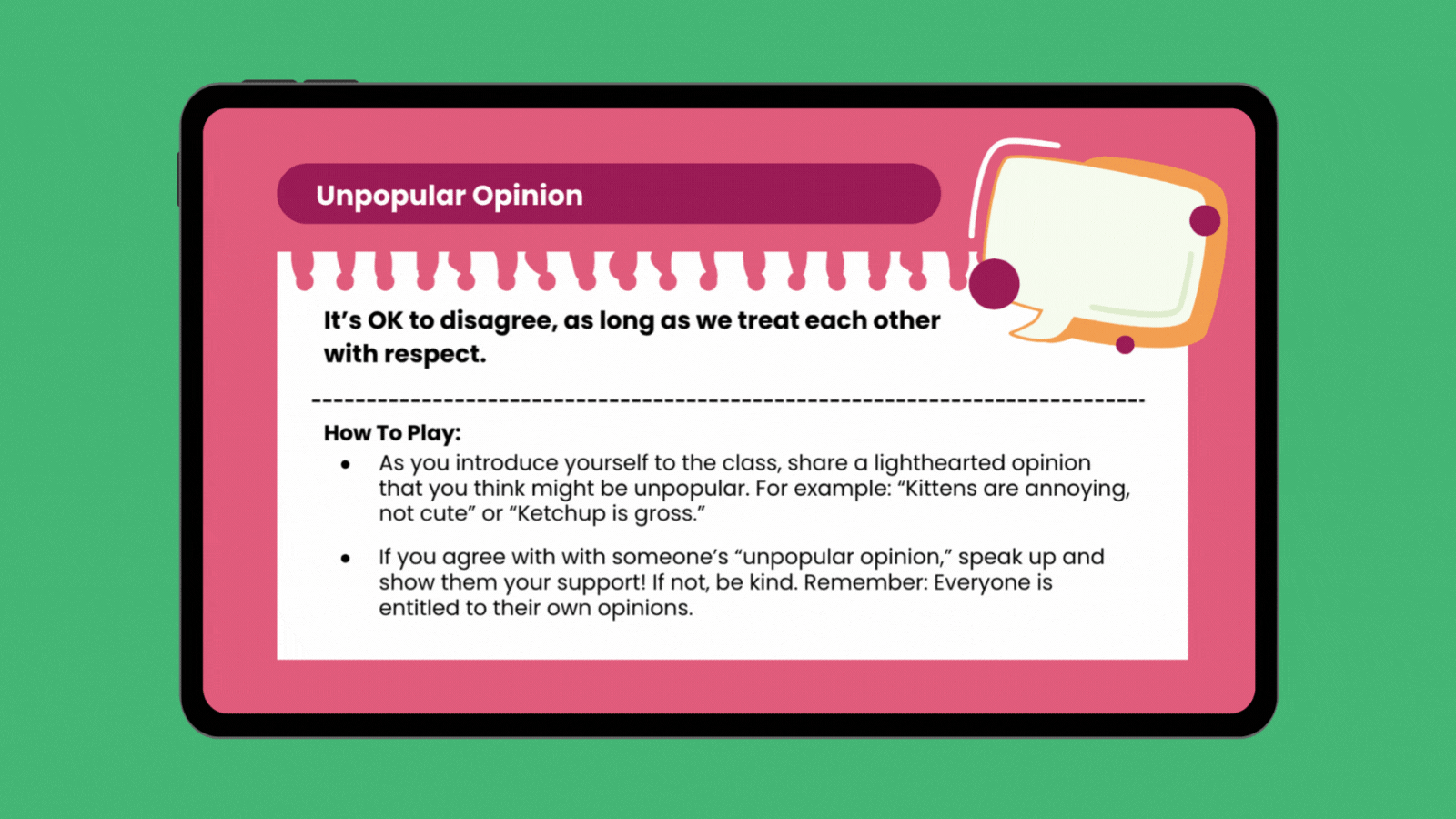
If you loved these icebreakers, grab our free printable Google Slides that include all of them.








Recent Comments